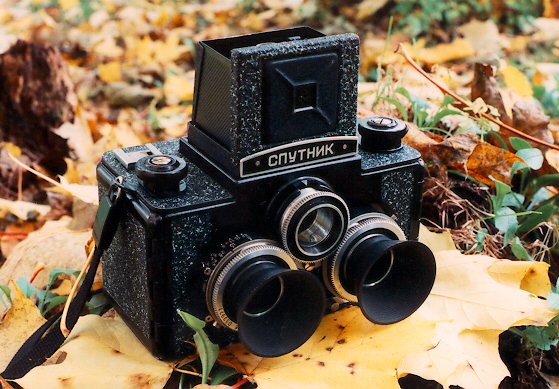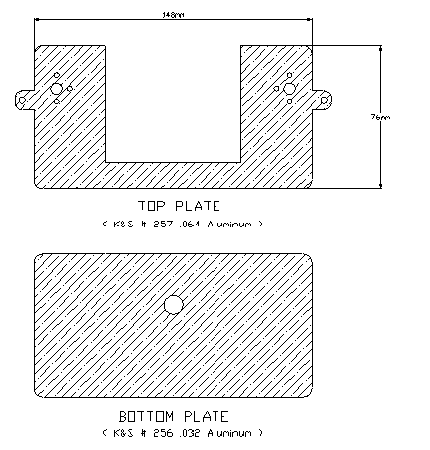
Notes:
HERE'S A BRIEF LIST OF RECOMMENDED MODIFICATIONS:
Internal ReflectionsProbably the silliest of design concepts was having a shiny surface to the inner chambers of the Sputnik. Light reflects off the sides and fogs the image, thereby greatly reducing contrast. There are two ways to reduce this: flocked paper and baffles.Flocked paper is a fuzzy black material that looks like very fine velvet. It is available from Edmund Scientific Co. at a very reasonable price. To line the inside, cut out separate pieces for each of the sides as well as top and bottom of the film chambers. Making a paper template first would be helpful. When they fit, glue them in place with contact cement.
|
|
| Baffling involves making walls inside the chambers to block the reflections. These can be made of cardboard, brass or aluminum. Mine were K&S #255 aluminum .016 thick. These were 53x55mm frame with 33x40 square openings. A 5mm bent strip along the edges was also needed for securing. This was painted and placed to butt up to the edges of the spool well. A slight bend on the top was needed to accommodate the mirror well. Next, I made a second set of baffles to go closer to the film plane. For these I used K&S #173 3/16" angled brass. This is a strip of brass with a 90 degree bend across its width, perfect baffling material. I cut and bent it into a couple of squares 57x53mm, painted them matt black, and stuck them inside 16mm from the film plane. All baffles were secured with contact cement. |
|
| One method is a camera bra. It has a similar function to the camera case, but it's more light tight. Using 1/8" matt board from a framer or art supplier, cut four pieces to cover the bottom, back, and sides. Leave about 1/8" each dimension, and leave an extra 1/8" width for the sides and bottom. Cut a hole for the film counter, measuring from the top of the board. Also cut a hole for the tripod socket, measuring from the front. Now tape these together with duct tape. It should fit loosely from the bottom and back. Now cut two pieces 2 1/2"x 3", and glue these vertically to the inside of the back, one butted up to each side. This gives a little groove for the door lock. Now cut 1/2" wide strips of matt board for the side, tops, and back. Cover the inside with black velveteen,and the outside with vinyl. A piece of vinyl attached to the front top corners of the sides will secure the front. You could even add latches for a strap. |  |
 |
The most effect option is to make a brass or aluminum plate that completely covers the top and bottom of the body. The top piece will be c-shaped to allow for the viewfinder, with holes for the knobs. If you drill holes in the top plate to allow for the six screws that attach the knob assemblies, you can simply attach the top plate with those screws without having to glue. This will cause the film posts that fit into your spools to not fit all the way down into the spools, so some modification would have to be done to the knob assemblies. You may also want to make little protrusions to hold the lug straps, especially if you don't use a case. The bottom will have a hole for the tripod mount. Attach velveteen around the door edges of the plates, then glue the base to the bottom using contact cement. The advantage to this method is that it allows you to include lugs for your camera strap as well as a flash shoe. |
|
 |
I would like to thank John Bercovitz, Joel Alpers and Greg Erker for suggestions in this guide. If you have any comments or suggestions for this page, please email me at: 3dhacker@cadvision.com